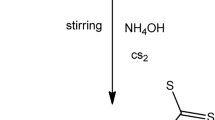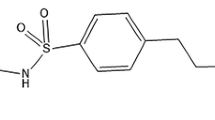Abstract
Mesalamine was labelled with technetium-99m (99mTc) in high radiolabelling yield (~98.4 %), in vitro stability (~4 h) and in serum persistence (~24 h). Optimum labelling conditions were investigated. The structure of the complex was confirmed using in silico analysis. Molecular docking was performed to evaluate the complex binding to its biochemical target, the PPARγ receptor. Biodistribution and clearance studies were performed in normal and ulcerative colitis models in mice. The tracer’s localization was highest (~65.2 %) in microbial model compared to chemical model (~42.4 %) and normal mice (~22.1 %) at 60 min post injection. All data supported the usefulness of 99mTc-mesalamine as a radiotracer for ulcerative colitis.










Similar content being viewed by others
References
Langhorst J, Elsenbruch S, Mueller T, Rueffer A, Spahn G, Michalsen A, Dobos G (2005) Comparison of 4 neutrophil-derived proteins in feces as indicators of disease activity in ulcerative colitis. Inflamm Bowel Dis 11:1085–1091
Sunkara S, Swanson G, Forsyth C, Keshavarzian C (2011) Chronic inflammation and malignancy in ulcerative colitis. Ulcers. doi:10.1155/2011/714046
Xiang J, Ouyang Q, Li G, Xiao N (2008) Clinical value of fecal calprotectin in determining disease activity of ulcerative colitis. World J Gastroenterol 14(1):53–57
Neishaboori H, Taghvaei T, Maleki I, Nagshvar F, Fakheri H, Hosseini V, Valizadeh S (2013) Calprotectin: a promising non-invasive tool for ulcerative colitis monitoring. Life Sci J 10(3):1356–1360
El-Kawy O, Ibrahim I, Farah K (2015) Technetium-99m labeling and evaluation of olsalazine: a novel agent for ulcerative colitis imaging. J Label Radiopharm. doi:10.1002/jlcr.3306
Dubuquoy L, Jansson E, Deeb S, Rakotobe S, Karoui M, Colombel J, Auwerx J, Pettersson S, Desreumaux P (2003) Impaired expression of peroxisome proliferator-activated receptor γ in ulcerative colitis. Gastroenterology 124:1265–1276
Vamecq J, Latruffe N (2000) Peroxisome proliferator-activated receptors (PPARs) and their implications in diseases. Curr Opin Endocrinol Diabetes 7:8–18
Kliewer S, Umesono K, Noonan D, Heyman R, Evans R (1992) Convergence of 9-cis retinoic acid and peroxisome proliferator signalling pathways through heterodimer formation of their receptors. Nature 358(6389):771–774
Su C, Wen X, Bailey S, Jiang W, Rangwala S, Keilbaugh S, Flanigan A, Murthy S, Lazar M, Wu G (1999) novel therapy for colitis utilizing PPAR-gamma ligands to inhibit the epithelial inflammatory response. J Clin Investig 104(4):383–389
Desreumaux P, Dubuquoy L, Nutten S, Peuchmaur M, Englaro W, Schoonjans K, Derijard B, Desvergne B, Wahli W, Chambon P, Leibowitz M, Colombel J, Auwerx J (2001) Attenuation of colon inflammation through activators of the retinoid X receptor (RXR)/peroxisome proliferator–activated receptor γ (PPARγ) heterodimer: a basis for new therapeutic strategies. J Exp Med 4:827–836
Yang X, Wang L, Chen T, Hodge D, Resau J, DaSilva L, Farrar W (2000) Activation of human T lymphocytes is inhibited by peroxisome proliferator-activated receptor gamma (PPARgamma) agonists. PPARgamma co-association with transcription factor NFAT. J Biol Chem 275(7):4541–4544
Marx N, Mach F, Sauty A, Leung J, Sarafi M, Ransohoff R, Libby P, Plutzky J, Luster AD (2000) A Peroxisome proliferator-activated receptor-gamma activators inhibit IFN-gamma-induced expression of the T cell-active CXC chemokines IP-10, Mig, and I-TAC in human endothelial cells. J Immunol 164(12):6503–6508
Yamamoto-Furusho J, Jacintez-Cazares M, Furuzawa-Carballeda J, Fonseca-Camarillo G (2014) Peroxisome proliferator-activated receptors family is involved in the response to treatment and mild clinical course in patients with ulcerative colitis. Dis Markers. doi:10.1155/2014/932530
Dubuquoy L, Rousseaux C, Thuru X, Peyrin-Biroulet L, Romano O, Chavatte P, Chamaillard M, Desreumaux P (2006) PPARγ as a new therapeutic target in inflammatory bowel diseases. Gut 55(9):1341–1349
Kruis W, Schreiber I, Theuer D, Brandes J, Schütz E, Howaldt S, Krakamp B, Hämling J, Mönnikes H, Koop I, Stolte M, Pallant D, Ewald U (2001) Low dose balsalazide (1.5 g twice daily) and mesalazine (0.5 g three times daily) maintained remission of ulcerative colitis but high dose balsalazide (3.0 g twice daily) was superior in preventing relapses. Gut 49(6):783–789
Desreumaux P, Ghosh S (2006) Mode of action and delivery of 5-aminosalicylic acid: new evidence. Aliment Pharmacol Ther 24(1):2–9
Yang J, Chen C (2004) GEMDOCK: a generic evolutionary method for molecular docking. Proteins 55:288–304
Gampe J, Montana V, Lambert M, Miller A, Bledsoe K, Milburn M, Kliewer S, Willson T, Xu H (2000) Asymmetry in the PPARgamma/RXRalpha crystal structure the molecular basis heterodimerization among nuclear receptors. Mol Cell 5:545–555
Shah S, Khan A, Khan M (2011) Radiosynthesis and biological evaluation of 99mTc(CO) −3 sitafloxacin dithiocarbamate complex: a promising Staphyloccus aureus infection radiotracer. J Radioanal Nucl Chem 288:131–136
Wang X, Zhao L, Han T, Chen S, Wang J (2008) Protective effects of 2,3,5,4′-tetrahydroxystilbene-2-o-beta-d-glucoside, an active component of polygonum multiflorum thumb on experimental colitis in mice. Eur J Pharmacol 578:339–348
Westin S, Kurokawa R, Nolte R, Wisely G, McInerney E, Rose D, Milburn M, Rosenfeld M, Glass C (1998) Interactions controlling the assembly of nuclear-receptor heterodimers and co-activators. Nature 395:199–202
Stretch G, Campbell B, Dwarakanath A, Yaqoob M, Stevenson A, Morris AI, Rhodes JM (1996) 5-amino salicylic acid absorption and metabolism in ulcerative colitis patients receiving maintenance sulphasalazine, osalazine or mesalazine. Aliment Pharmacol Ther 10:941–947
Author information
Authors and Affiliations
Corresponding author
Rights and permissions
About this article
Cite this article
El-Kawy, O.A., Sanad, M.H. & Marzook, F. 99mTc-Mesalamine as potential agent for diagnosis and monitoring of ulcerative colitis: labelling, characterisation and biological evaluation. J Radioanal Nucl Chem 308, 279–286 (2016). https://doi.org/10.1007/s10967-015-4338-4
Received:
Published:
Issue Date:
DOI: https://doi.org/10.1007/s10967-015-4338-4




